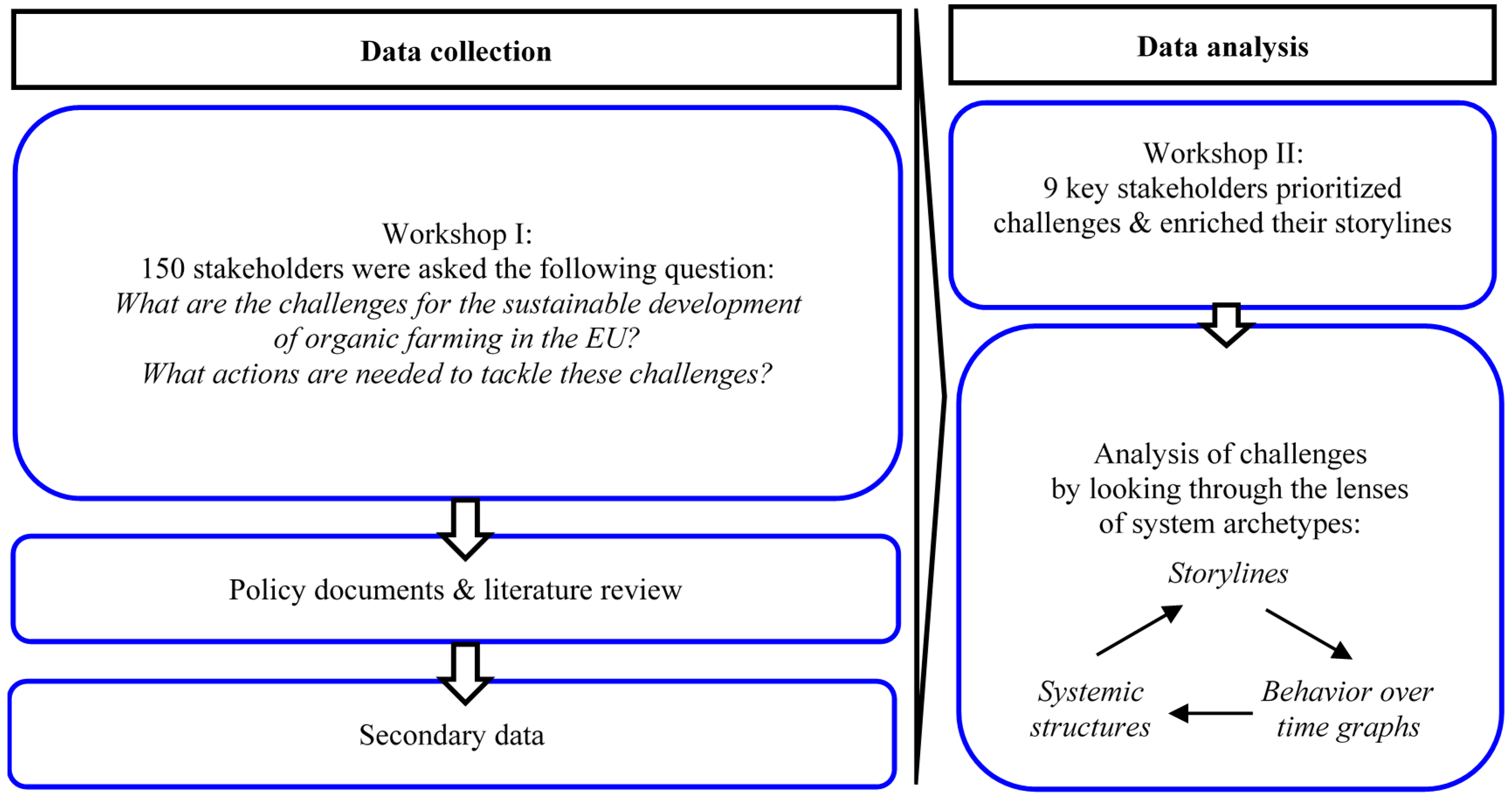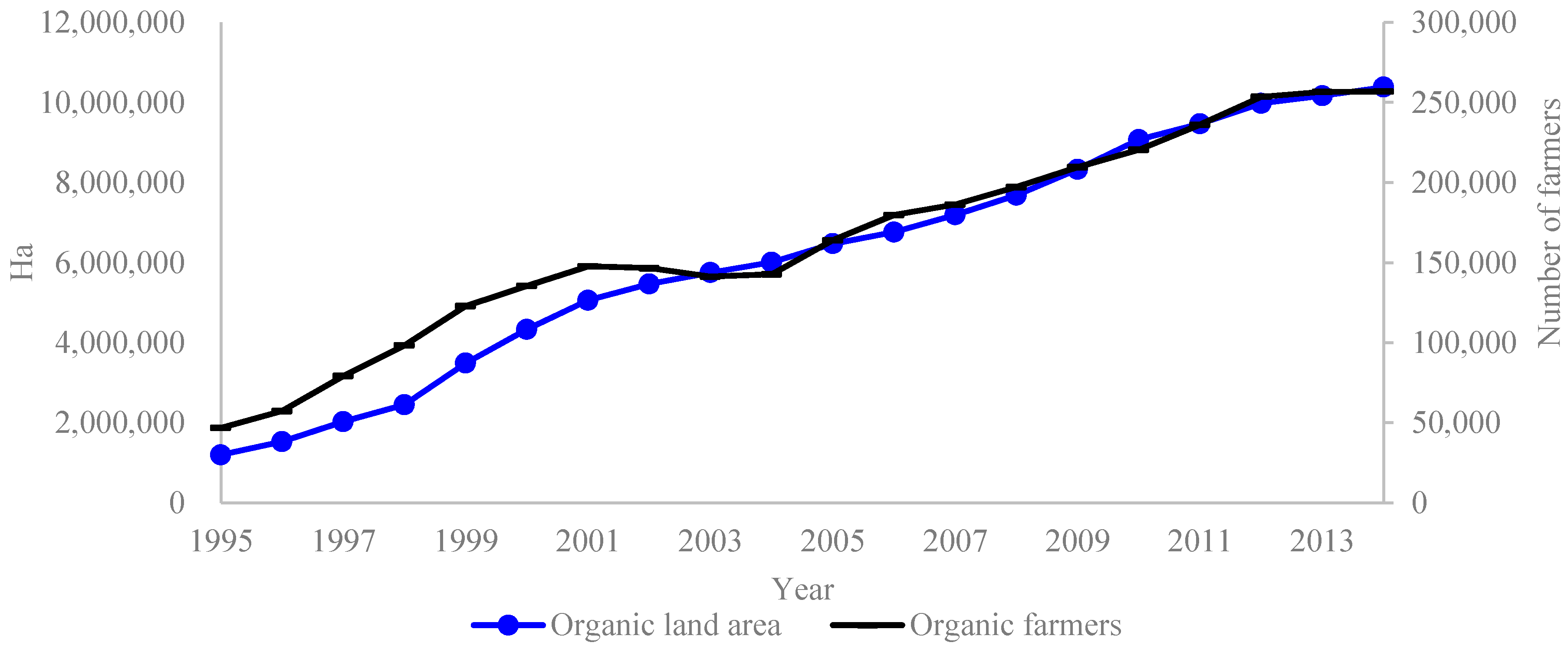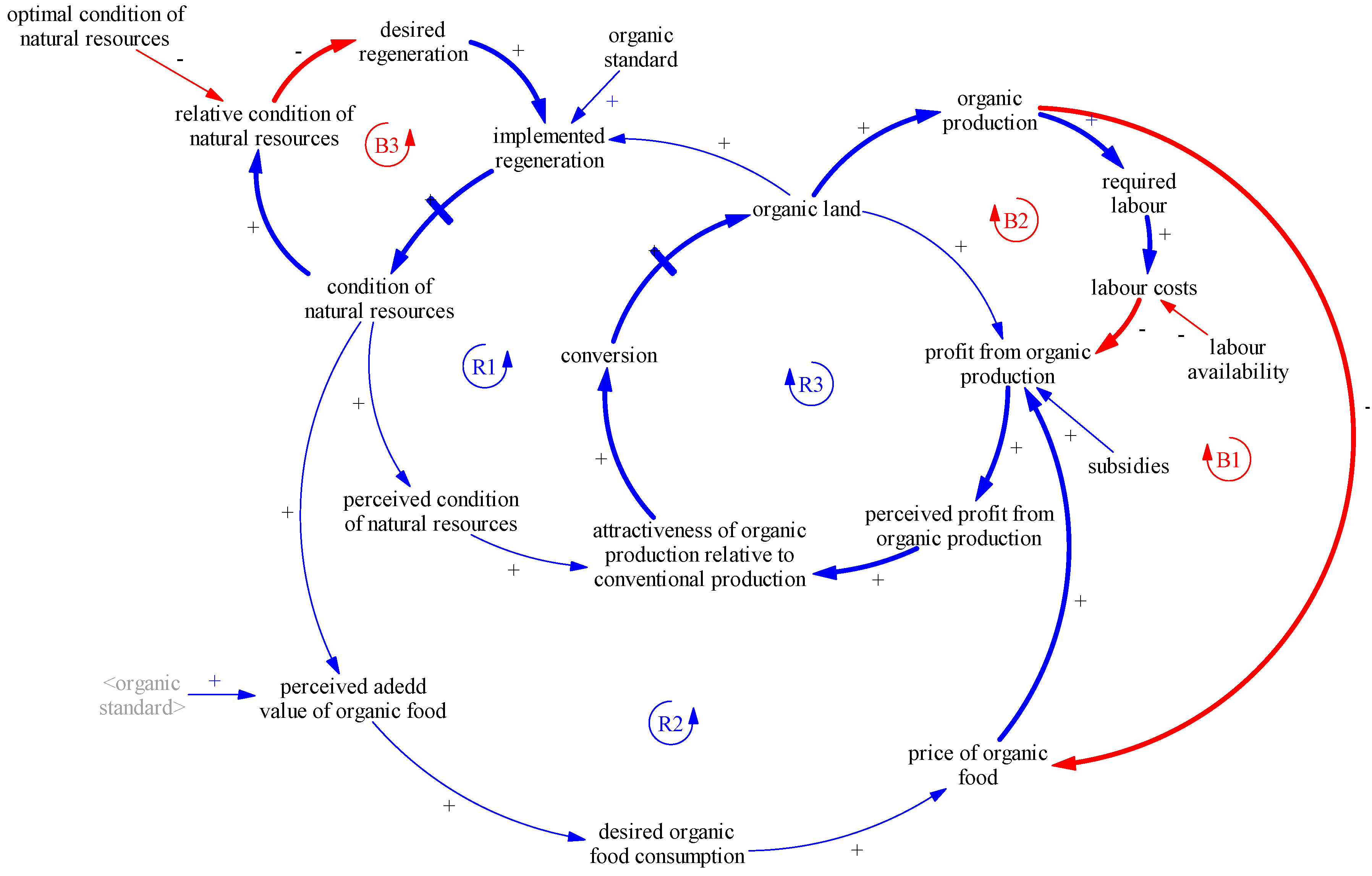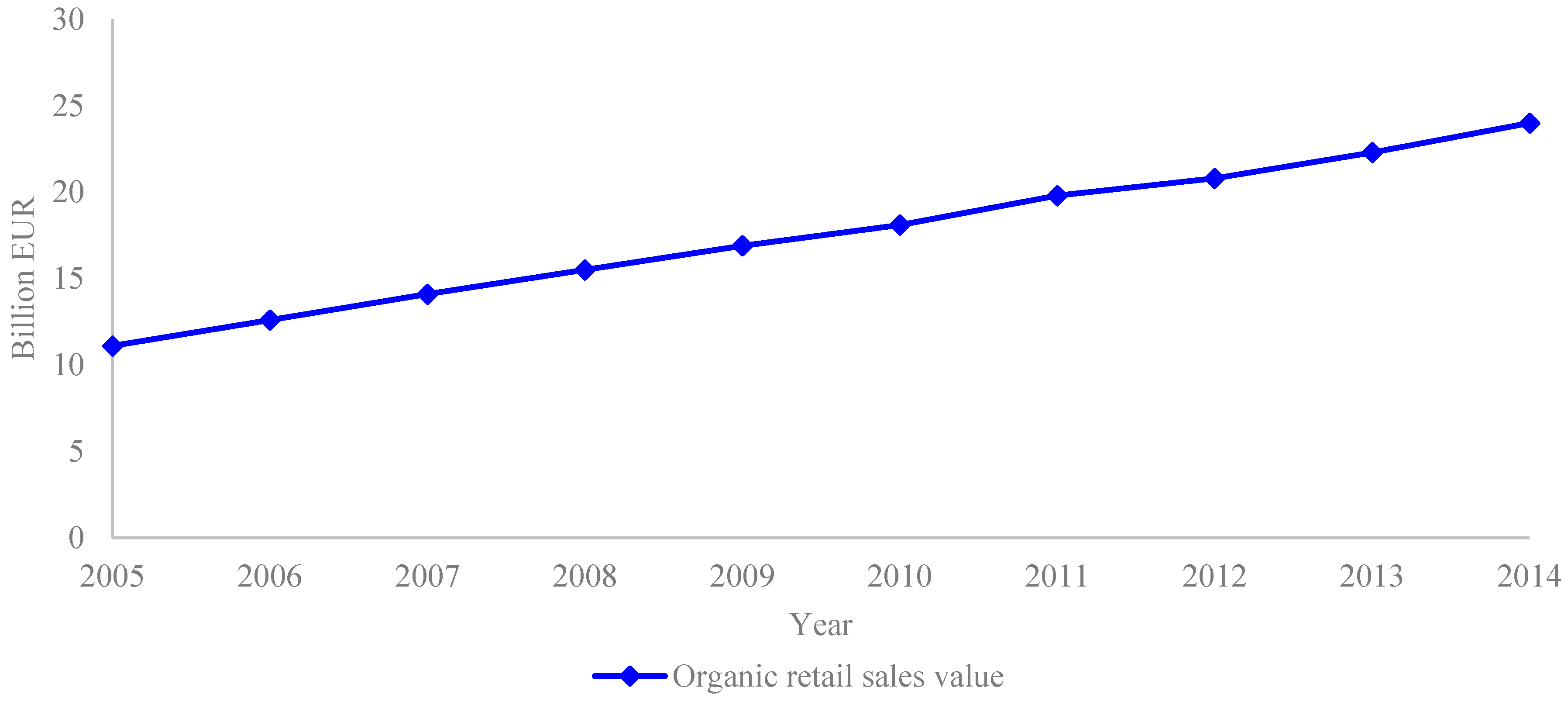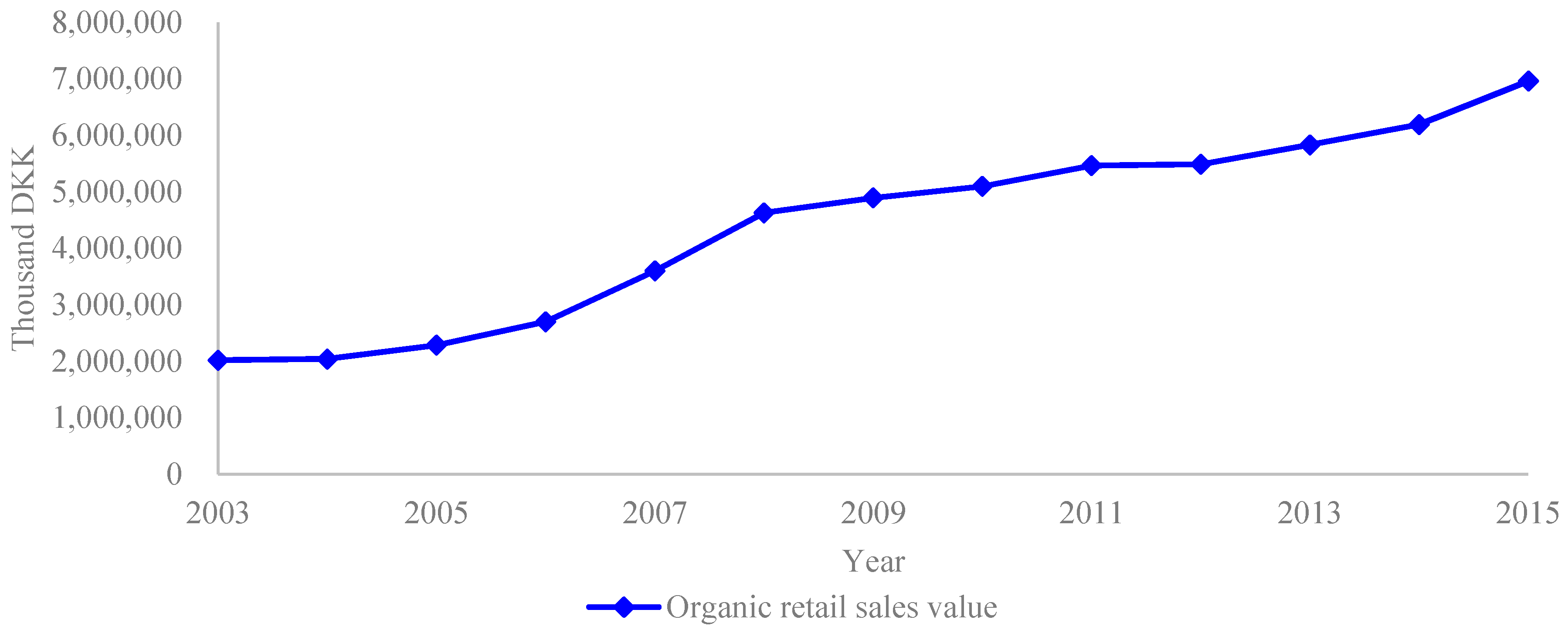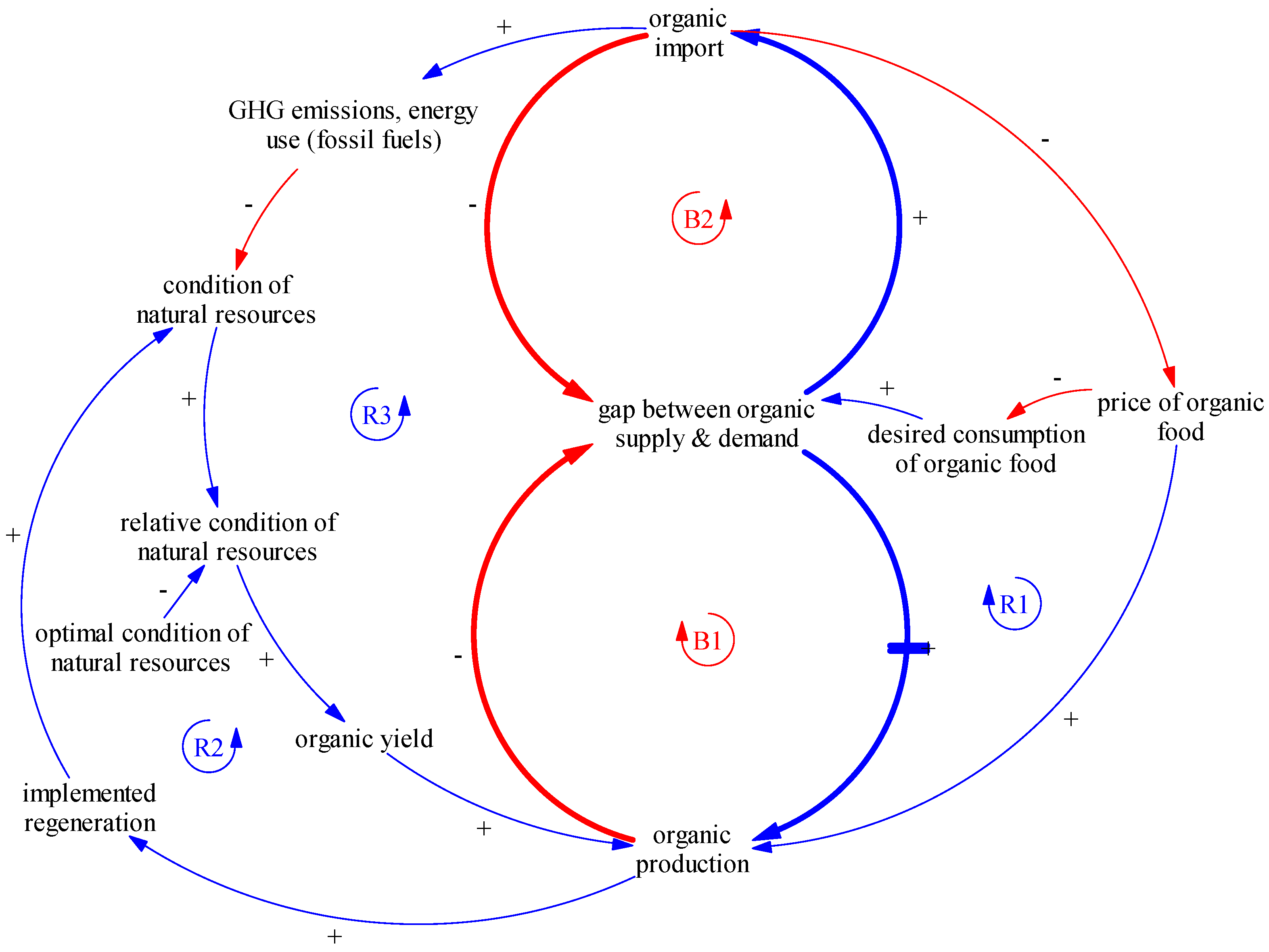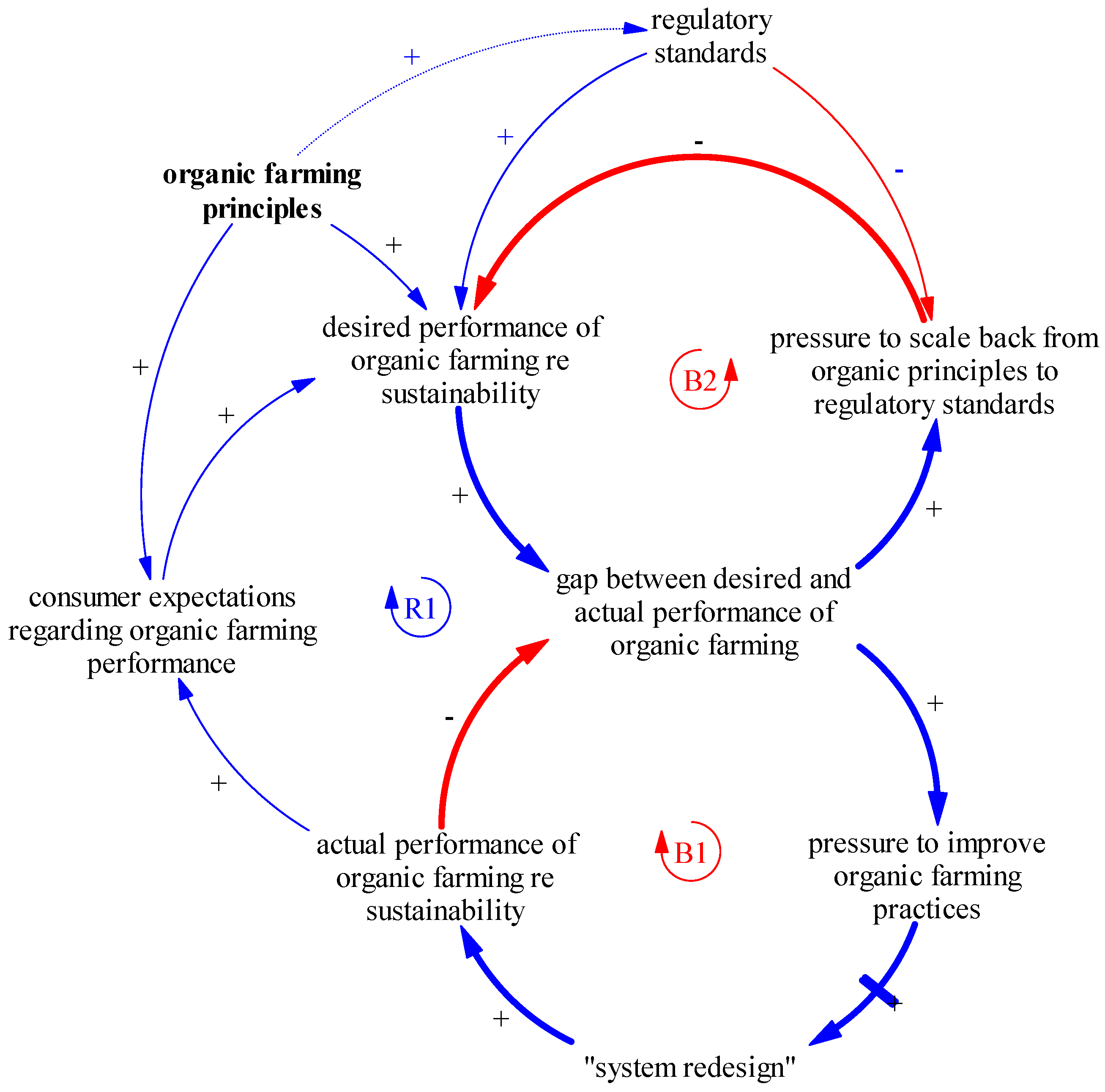The stakeholders vision of organic farming is an environmentally conscious, healthy, fair, and caring food system widely adopted in Europe. In this food system, multiple sustainability goals, i.e., food and nutrition security, socio-economic and environmental welfare, are well balanced. High quality food is produced in sufficient quantities for all consumers and all consumers also have access to a healthy diet. At the same time, natural and human resources are managed in a sustainable manner, implying that the environment and viability of rural areas are preserved, and farmers and farm workers are treated fairly.
According to the stakeholders the vision of organic farming system cannot be achieved if the following three main interrelated challenges are not effectively addressed. First, on average, only ~5.9% of UAA (utilized agricultural area) in Europe is under organic cultivation and only ~2% of the turn-over of the EU food and drink industry constitute sales of organic food products [
12,
14]. If organic farming remains a niche, its principles would be adopted only on a negligible scale and hence benefits that the food system brings would be limited. Second, organic production in the EU is lagging behind the growth of the organic market. In an increasingly globalized and liberalized market, there is a risk that growing demand will be met by imports, and that organic farming will lose its integrity [
12,
14,
15]. The so-called conventionalization of organic farming is the third challenge. The process seems to intensify as the organic farming system grows [
1,
16,
17]. Many examples show that organic farmers, especially the late adopters and the larger ones, simply substitute banned for allowed inputs rather than redesigning the system in accordance with organic farming principles [
44,
45]. This and other signs indicate that an organic food system based on certification of food production methods alone is not enough to escape the pressures towards conventionalization that endanger the potential of organic farming to be a more sustainable alternative to the prevailing food system in the EU [
18,
45].
In this section, we look at the three main challenges facing the sustainable development of organic farming in the EU through the following system archetypes lenses: Limits to Growth, Shifting the Burden and Eroding Goals. With the first system archetype—Limits to Growth—we analyze why organic farming remains a niche sector in Europe and hence why its principles are only enacted on a limited scale. The second system archetype—Shifting the Burden—brings insights into the risks associated with the increasingly anonymous and globalized market of organic food in the EU. The third system archetype—Eroding Goals—investigates the issue of conventionalization that undermines the credibility of organic farming system in the EU. For each archetypes we provide and discuss strategies for moving organic farming in Europe forward so as to maximize its potential contribution to sustainability.
3.1. Limits to Growth: Moving Organic Farming Out of the Niche
From the archetype Limits to Growth we can learn that a positive reinforcing behavior is always accompanied by balancing processes that will eventually limit efforts put into driving the growth. When a system’s performance starts to decline, decision makers are typically inclined to put further effort into reinforcing growth, rather than focusing on managing the limits [
39,
40]. The growth of organic farming in the EU, in particular the number of organic producers and the area of organically cultivated land, resembles the archetypical behavior of Limits to Growth (
Figure 3).
At the beginning of the last century, organic farming was evolving without policy interventions [
1,
46]. Its development was driven mainly by two interconnected reinforcing feedback loops, R1 and R2 (
Figure 4). In these loops, concerns about sustainability issues, foremost deteriorating natural resources, motivated farmers to convert to organic farming and implement environmentally benign practices (R1;
Figure 4) [
1,
26,
47], and motivated consumers to compensate organic farmers for their efforts implementing organic principles in practice (i.e., internalizing externalities such as protection of the environment, animal welfare, etc.) [
11] (R2;
Figure 4) [
48,
49]. Specifically, the reinforcing loops operate as follows: by implementing inter alia regenerative practices such as diverse and companion cropping or planting green manure and cover crops, the condition of natural resources (e.g., soil carbon levels, soil quality, biodiversity, etc.) improves [
6]. As enhancements in the condition of natural resources become apparent, the perception that organic farming practices’ contribute to environmental protection becomes more widespread. This in turn, translates to higher attractiveness (i.e., expected utility from an environmental perspective) of organic farming relative to conventional agriculture, and hence more farmers decide to convert [
50] (R1;
Figure 4). At the same time consumers increasingly perceive the added-value of organic products (i.e., they see organic food as environmentally-friendly, healthy, safe and of high quality), and hence the desire to buy organic food (demand) rises. Accordingly, the price of organic food, profits and attractiveness of organic farming to farmers also increase, encouraging more farmers to decide to convert to organic farming (R2;
Figure 4).
The state of affairs had changed by around the 1980s–1990s. In response to increasing environmental concerns and demand for organic products, policymakers introduced a range of specific legislative, financial and communication measures [
51]. First, organic standards, i.e., the EU Council Regulation 2092/91 (current version: Council Regulation 834/2007) and associated legislation, were implemented in order to protect market participants from free riders labeling their conventional products “organic” or “bio” to capitalize on price premiums. Through this legislative framework policymakers strengthened the two reinforcing feedback loops R1 and R2 (
Figure 4).
The organic standards provided a legal definition of organic farming that enabled ipso facto within the framework of the Common Agricultural Policy (CAP) the introduction of specific financial support for farmers that aimed at encouraging the conversion of at least a portion of a farm’s land and/or to maintain organic food production [
11,
46]. In addition to specific support for organic farming, organic farmers also benefited from the introduction of direct payments, a key element of the general CAP [
1]. According to many studies, the subsidy-focused policy measures, which are in place until today, considerably improved the economic situation of organic farmers [
46]. Hence, these measures gave momentum to the development of organic farming through strengthening an additional reinforcing feedback loop R3 (
Figure 4), in which farmers convert to organic farming guided mainly by profit maximization [
24,
26,
46,
47,
52]. Specifically, as organic farming proves to be more profitable with subsidies and price premiums in comparison to conventional agriculture [
22,
53], more and more farmers perceive it to be a better option for maximizing profit. With farmers having a more positive perception of the profitability of organic farming, the attractiveness (i.e., expected utility from an economic perspective) of organic relative to conventional agriculture rises [
24,
26,
46,
47,
52]. Accordingly, the conversion rate and hence the number of organic farmers increases. This indeed also leads to an increasing amount of organically farmed land and organically raised livestock [
12,
24,
46,
52]. In turn, as a large proportion of financial support is granted to organic farmers in the form of subsidies for the area of land they manage and/or own, more land, ceteris paribus, leads to higher profit. Therefore, organic farmers are incentivized to increase farm size, while conventional farmers are motivated to convert as much of their land as possible into the organic scheme [
54,
55]. To recap, the higher the conversion rate, the more organic land is in the system, the more profits can be realized, the higher the perception of improved profitability and hence the greater the attractiveness of converting land, and finally again the higher the conversion (R3;
Figure 4).
Finally, in addition to standards and subsidies, support for organic farming has been expanded to include a range of communication policy measures that stretch into fields such as research, advisory services and promotional campaigns directed to consumers [
11].
The three reinforcing feedback loops—R1, R2, and R3 (
Figure 4)—have been the major growth engines for the dynamic development of organic farming in the EU, especially in the early years after the introduction of governmental support. Indeed, between 1985 and 2010 certified and policy supported organic farmland in Europe increased from 105,000 ha (less than 0.1% of the total UAA) to 9,031,070 ha (around 5% of the total UAA). During the same period the number of organic farmers in the EU increased from 6600 to 186,250 (
Figure 3) [
12,
13].
However, since 2010 these growth engines (i.e., reinforcing feedback loops R1, R2, R3;
Figure 4) have begun losing their effectiveness; the rate of growth has started to flatten, and this is particularly apparent when looking at the evolution of the number of organic farmers (
Figure 3). In some individual Member States conversion has stopped all together, and in others it is even being reversed, despite continued pressure from the growth engines. For instance, in 2014, a major decrease was noted for the United Kingdom (37,000 ha) [
12]. It thus seems as if the growth of organic farming in the EU is approaching its limits.
The Way Forward
Whether the development of organic farming in the EU is indeed approaching its limits, and if this is so what these limits are, is uncertain. It is certain, though, that there is no such thing as unlimited growth [
39]. Limits may emerge, and most likely will emerge, either from within parts of the system or from the external environment [
40]. The real leverage does therefore not lie in pushing harder on engines of growth, in other words strengthening the reinforcing feedback loops R1, R2 and R3 (
Figure 4 and
Figure 5) with increased focus on what initially worked, i.e., legislation and land-based subsidies. The latter particularly is constrained by budget, which limits the possibility of increasing or even just maintaining the current levels of agri-environmental support in many Member States [
46]. The most effective way forward is therefore to redirect efforts away from driving the reinforcing process of growth to instead anticipating limits and ultimately removing them or weakening their effects before they begin to undermine growth [
39,
40].
To make this recommendation tangible for the case of organic farming in the EU, we provide three examples of limiting pressures—price squeeze (B1;
Figure 5), labor intensiveness (B2;
Figure 5) and lack of motivation to implement regenerative practices (B3;
Figure 5)—that arise from the growth process. We discuss each balancing process in terms of its broader implications for the sustainable development of organic farming. Following this we briefly indicate potential actions that could remove these balancing processes or at least weaken their effects.
The first balancing loop (B1;
Figure 5) relates to the dynamics between supply, demand and price on competitive agri-food markets [
18,
33,
56]. When organic production increases, all else equal, the price of organic food decreases. While lower prices of organic food are desirable from the consumer’s perspective and may to a certain extent be able to stimulate demand, for farmers, it means lower profit. Hence, once the supply of organic food outpaces the demand, the price of organic food falls, as so does the profit realized by organic farmers. Consequently, the reinforcing upward spiral driving the growth of organic production (R3;
Figure 5) is at risk of turning into a reinforcing downward spiral, which then requires substantial efforts in terms of time and money to be reversed. The balancing loop (B1;
Figure 5) thus reduces the effectiveness of subsidies and endangers the economic viability of organic farm operations in the long run. Smith and Marsden point to signals that such dynamics have already emerged in the UK organic dairy, lamb and horticulture sector, and put into question the potential of organic farming to deliver wider and lasting rural development benefits [
57].
The second balancing loop arises around production inputs, in our example this is specifically labor force (B2;
Figure 5). In many studies, higher labor intensity of organic production methods is cited as one of the most important barriers to conversion [
23,
58,
59]. The growth in organic production implies thus, ceteris paribus, that more labor is required to perform the different farming activities. On the one hand, some consider this as an opportunity for reducing unemployment [
6,
14,
60]. On the other hand, employing more farm workers generates significantly higher costs (7–13%) [
22,
53] and hence reduces farm profit, potentially leading to an undesirable change in direction of the reinforcing spiral (R3,
Figure 5). Moreover, since current organic standards do not cover social values [
61], this cost pressure might force farmers into unfair labor practices and thus to violating the fairness principle.
Apart from the tangible elements in the system, there are also intangible ones, such as attitudes, values, beliefs, feelings, and relationships. The third balancing feedback loop (B3;
Figure 5) is an example of a limiting process that emerges from the latter, i.e., the motivation to enhance the condition of natural resources beyond the current level. Namely, the more organic land is in the system, the more widespread are regenerative practices, and thus the condition of natural resources improves (R1;
Figure 5). However, as the actual condition of natural resources approaches the optimal level (i.e., the relative condition of natural resources increases), the desire to further implement regenerative practices decreases. Hence, the reinforcing feedback loops lose their strength (R1 and partly R2;
Figure 5) as fewer and fewer farmers (along with some consumers) feel the need to improve the condition of natural resources [
18,
36]. The balancing loop thus lessens the effectiveness of organic standards and directly undermines the possibility that the principle of ecology is enacted on a broader scale.
In order to weaken the effect of the first price-related balancing process (B1;
Figure 5), instead of rewarding organic farmers for delivering public goods with subsidies, decision makers should find more effective ways of internalizing externalities in the price of all foodstuffs [
62]. In other words, the price of food should better reflect many of the socially and ecologically progressive attributes of organic produce which are currently neglected. In this way, the effect of the demand/supply balance on price can be reduced on account of the true costs and benefits of food production systems. Further, to resolve the issue of the limiting mechanisms related to labor intensity (B2;
Figure 5), it is not enough to build on the experience of other ethical standards (e.g., Fairtrade), and include fair labor practices in the organic standards, as recommended by several stakeholders related to the organic sector. This solution further increases labor costs and hence reduces profit of organic farmers. Decision makers should stimulate competitiveness in terms of fair labor practices by internalizing them along with other externalities in the price of all kinds of foods, not just in the certified as organic or Fairtrade. Finally, the balancing loop related to the declining motivation to implement regenerative practices (B3;
Figure 5) can be weakened or even removed with the implementation of a new system. In this system farmers are rewarded based on continuous improvements rather than on the fulfillment of minimum standards.
Many other limiting processes both from within and outside the system could be identified. In fact, each variable within a growth engine (R1, R2, R3;
Figure 4) is an entry point for limiting pressures. These pressures should be prioritized over to the engines of growth, even before they become apparent, if the desire is to develop organic farming in the EU in a sustainable way. “
As the harder we push the engines of growth, the harder the system’s limits push back” [
39]. However, this strategy may involve taking politically and technically difficult steps and overcoming considerable resistance from different interest groups [
39,
40,
63]. A vivid example is the ongoing negotiations on the new organic regulation between the three EU institutions—the Council, the Parliament and the Commission—that have already set a record length among agriculture dossiers. The negotiations have already lasted more than three years due to the many points of disagreement.
3.2. Shifting the Burden: Finding Balance between Locally Produced and Imported Organic Food
The system archetype Shifting the Burden relates to situations in which a problem can be addressed by either a quick and easy symptomatic fix or a fundamental solution which requires a considerable amount of time and effort. The lesson of this archetype is that a quick and easy fix will typically temporarily reduce symptoms, while diverting attention away from the implementation of a solution that addresses the core of the problem. After some time the problem recurs, often much bigger, and again more often than not a symptomatic rather than fundamental solution is turned to [
40].
The dynamics of the organic agri-food market match the Shifting the Burden archetype. Over the last ten years, organic retail sales in the EU have experienced extraordinary growth. Specifically, between 2005 and 2014, the total value of the organic retail market more than doubled, increasing from €11 billion in 2005 to €24 billion in 2014 (
Figure 6). Within the same time period, the consumption of organic food has augmented from €22.4 to €47.4 per capita. This 110% is much larger than the 13% increase in total household consumption of food and non-alcoholic beverages [
12]. If we extrapolate the growth of organic retail sales (
Figure 6), the future of the European organic farming system seems promising. However, when contrasted with the slowing growth of European organic land area and organic farmers (
Figure 3), the outlook is less optimistic.
During the last policy impact assessment exercise carried out by the European Commission [
14], an exercise that involved a large number of stakeholders, policymakers concluded that “[…]
the overall objective of the current EU political and legislative framework, which is the sustainable development of organic production, is not met”. A reason for this is the widening gap between the rapidly growing desired consumption of organic food (visible in retail sales) and the slowing development of domestic organic food production [
14]. This gap is the system’s core problem, indicating that the potential economic, social and environmental benefits of organic farming in the EU are not fully realized [
14]. To solve this and other associated problems, in 2014 a legislative proposal for new regulation of organic production and labeling of organic products was adopted, and to this day it is under negotiations [
64]. The European Commission has also adopted an Action Plan on the Future of Organic Production in Europe to help organic farmers, producers and retailers adjust to the new policy and meet future challenges [
65].
Policymakers along with the organic farming movement perceive the fundamental solution as one that removes barriers and encourages the development of organic food production inside the EU [
12,
14]. If we look at it through the Shifting the Burden lens, this means they advocate strengthening the balancing loop B1 (
Figure 9). This loop illustrates that the wider the gap between organic production and consumption, the higher the pressure to increase domestic organic food production. In turn, the domestic organic food production increases and the gap diminishes. However, there is a delay in this balancing loop (B1;
Figure 9). Specifically, it takes a considerable amount of time, effort and financial means to inter alia develop, negotiate and implement new policies, or conduct research and build appropriate capacity to produce food using organic farming practices at the farm level.
In contrast, large food retailers, which throughout the years have become the major market channel in the EU (i.e., a process known as supermarketization) [
12], turn to importers in order to quickly satisfy the demand for organic food (i.e., desired consumption of organic food) (B2;
Figure 9) and hence profit from the growth of the lucrative organic food market [
57]. Glancing between 2013 and 2014 only, the number of importers increased by 17% across the EU and significantly in almost all Member States [
12]. At the same time organic land area in the EU grew by 1.1%, but the number of organic farmers decreased by 0.2% [
12]. Apart from Denmark there are no data on trade flows. The Danish data show that between 2003 and 2015 organic retail sales (
Figure 7) along with imports (
Figure 8) were continuously growing, while at the same time the organic land area remained more or less constant (
Figure 8). Imports, from the perspective of large retailers, are a relatively easy and quick fix for the misbalance on the organic food market in the EU (B2;
Figure 9). Through imports a balancing feedback loop B2 (
Figure 9) is created. In this loop, the wider the gap between organic production and desired consumption, the higher the pressure to import organic food. As more organic food is imported, all else equal, the gap diminishes (B2;
Figure 9).
As a result, by importing organic food, the problem’s symptom (i.e., gap between demand and supply) eases (at least for a while), and the pressure to develop domestic organic food production, which is more difficult and time-consuming, weakens. Lurking behind this apparently easy and quick solution, i.e., imports (B2;
Figure 9), are numerous reinforcing processes that unintendedly undermine the possibility to implement the fundamental solution, i.e., the development of domestic food production (B1;
Figure 9).
Figure 9 illustrates three examples of these unintended reinforcing feedback loops that lead to a price squeeze (R1), decline in implementation of practices regenerating natural resources (R2) and degradation of natural resources (R3).
The first unintended reinforcing feedback loop (R1;
Figure 9) arises from the market-based mechanisms on which organic farming relies. As the organic food market is increasingly supplied by imports, the price of organic food, especially at the farm gate, falls [
57]. In turn, a lower price, ceteris paribus, implies lower profits, and hence reduced incentive for European farmers to produce in an organic manner. Consequently, the gap between domestic organic food production and desired organic consumption widens further, increasing again the need for imports. The reinforcing feedback loop R1 (
Figure 9) is a vicious circle that leads to a lack of long-term viability for organic farms and thus limits the potential of organic farming to be an engine of rural development [
57].
The second and third unintended reinforcing feedback loops emerge from the interplay between economic and environmental dynamics (R2 and R3;
Figure 9). On the one hand, as imports increasingly take over domestic organic food production, organic farming practices that regenerate the condition of natural resources are increasingly implemented outside the EU. Accordingly, the condition of natural resources inside the EU, all else equal, deteriorates. This means that organic farming, a low external input system with successful implementation relying heavily on a healthy environment (such as high levels of organic matter in soils), becomes less effective and achieves lower yields, with organic food production ultimately declining further (R2;
Figure 9) [
18,
36]. On the other hand, importing food, whether organic or not, is transport-intensive and increases food-miles [
62]. With increasing transportation, energy use (foremost fossil fuels) and hence greenhouse gas (GHG) emissions rise and lead to a degradation of the condition of natural resources, again installing barriers to effective implementation of organic farming. In combination, the second and third reinforcing feedback loops (R2 and R3;
Figure 9) are vicious circles that strengthen each other and limit the production capacity of the organic farming system in the EU, thereby increasing the need to outsource organic food production to third countries. In a wider sense, these two feedback loops (R2 and R3;
Figure 9) undermine the potential of organic farming to contribute to long-term environmental sustainability in the EU and beyond.
Overall, with increasing organic food imports, the impact of associated side-effects is strengthened through the reinforcing feedback loops, and the ability to develop domestic organic food production spirals downward faster and faster (R1, R2 and R3;
Figure 9). Consequently, the European organic farming system becomes increasingly dependent on third countries and their natural (and other) resources to satisfy the desired consumption of organic food. The increasing dependency magnifies the system’s exposure to various crises of ecological as well as economic origin occurring abroad. It also highlights the fact that organic food is becoming decreasingly synonymous with regional food and therefore puts in question the sustainability of the organic farming system in the EU. In turn its sustainability is of increasing importance to consumers and a pertinent reason why the system developed in the first place [
62].
The Way Forward
Shifting the Burden is an example of a tension that arises due to pressure to satisfy the rising demand for organic food through imports in the short-term, while also trying to ensure the sustainable development of organic farming in the EU in the long-term. This archetype reveals how easy it is to undermine the implementation of the organic farming system in the EU and instead become dependent on third countries and their resources.
According to the generic strategies designed for Shifting the Burden situations, the highest leverage lies in avoiding this archetype all together or, if this is not possible, preventing it from becoming engrained in the system [
39,
40]. In order to prevent the Shifting the Burden archetype from becoming entrenched in the EU organic farming system, decision makers should be patient and stay focused on the objective of maximizing the contribution of organic farming to sustainability. This applies not only to policymakers and the organic farming movement, but also to all actors along the entire organic food supply chain (foremost processors and retailers). Taking into consideration the pivotal role of reputation (i.e., perception of consumers and producers) in fostering the development of organic farming system in the EU (see
Section 3.1: feedback loops R1, R2, and R3;
Figure 4) as well as the increasing importance of social media, public relations (PR) could be an important instrument for effecting and accelerating progress on the system’s sustainability. However, effective PR requires trust along with responsible, transparent and collaborative actions involving actors across the whole organic food supply chain [
57,
67]. It otherwise risks being a purveyor of ‘greenwash’ rather than an agent of systemic, desirable change. For instance, in the UK, numerous major supermarkets (e.g., Sainsbury, Tesco, Waitrose, etc.) developed and widely announced corporate sustainability strategies aimed at incentivizing greater domestic production of organic foods. However, whilst these major retailers continued communicating their support, to them organic food remained just another commodity range. Consequently supermarkets increasingly pushed organic farmers into the conventional socio-economic organization of food production by, inter alia, demanding large batches of standardized produce and squeezing farm-gate prices [
57,
67].
While staying committed to the development of sustainable domestic organic food production, decision makers could allow importation of organic food to bridge the shortage on the market. However, as the investment in the fundamental solution starts to take effect, they must gradually reduce the symptomatic solution (i.e., imports) to a level that better balances the multiple sustainability outcomes of the system (e.g., food security, income to societies and impacts on natural resources). To this end, decision makers could, for example, include in the organic standards, the proximity of production and consumption or the concept of global redundancy in food production as a safety feature. However, this strategy could be difficult to implement due to, inter alia, considerable resistance, foremost from the World Trade Organization (WTO).
Furthermore, it is also necessary to regularly monitor and report on the European organic farming system’s performance in terms of sustainability metrics and its dependency on third countries. This implies further development of data collection, which currently entails only a limited set of indicators. Specifically, innovative concepts such as virtual water and its derivative water footprint could be supportive as they reveal impacts of organic food production, consumption and trade which existing monetary indicators do not capture. For example, the virtual water flow approaches make the reallocation of water along the organic food supply chains more visible. Accordingly, integration of such concepts in analyses of other factors related to the system improves their comprehensiveness and, in turn, the understanding of fundamental issues related to the condition of natural resources within the boundaries of the EU as well as at a global level. This knowledge is important for decision makers (including consumers) to make informed choices and, thus, effectively reduce trade-offs between socio-economic and environmental outcomes as well as adjust to the new realities [
68,
69,
70,
71].
3.3. Eroding Goals: Escaping from Conventionalization of Organic Farming
Eroding Goals resembles the archetype Shifting the Burden. This system archetype relates to a situation in which a gap exists between desired and actual performance. The gap can be resolved by either lowering the goal (a quick fix) or implementing corrective action (a fundamental solution), which is often more difficult. Decision makers often change the goal to one that appears to be achievable rather than to do the crucial work needed to accomplish the goal. Over time, however, the performance of the system deteriorates [
40]. This said, the Eroding Goals archetype can also be reversed into a state where goals and performance continually improve [
39]. In this case, once the gap between desired and actual performance decreases, decision makers raise the goal and hence encourage additional corrective action. In such a way, the performance increases over time [
39].
How well organic farming performs in terms of sustainability metrics depends to a great extent on how well and how broadly organic principles and values are incorporated in practice [
61,
62]. This is particularly important in the context of a globalizing market (see
Section 3.2) [
16]. The role of standards in facilitating enactment of organic principles on a broader scale is contentious. On the one hand, critics consider standards as a driver of institutionalization or conventionalization of the organic sector [
72]. On the other hand, standards harmonize rules in the interest of fair competition and institutionally (re)establish consumer confidence in the organic food supply chain. In turn, consumers are able to contribute to the reproduction of shared values of organic farming through their choices of food products [
51,
73]. The bottom line is thus the adjustment between principles, rules and practice [
11,
16,
61].
According to Padel et al. [
61] and Milestad and Darnhofer [
74], organic farming principles and values were poorly integrated in the first EU Council Regulation 2092/91 (
Table 1). Looking through the lens of the Eroding Goals archetype, by implementing the regulatory standards, which only specify permitted and prohibited substances and practices at the cost of control over the process [
16,
62], the organic farming system is put on a trajectory of declining levels of performance. This trajectory is evident in the emergence of the organic conventionalization debate [
72,
75,
76,
77]. Organic producers have the choice to continuously improve their activities towards a holistic system redesign (B1;
Figure 10), or scale back the desired performance (i.e., goals) as set by the organic principles to the level of regulatory standards and simply substitute prohibited inputs and practices for permitted ones (B2;
Figure 10) [
44]. Over time, organic farmers (especially the late adopters) are becoming less and less dedicated to organic farming principles, yet more profit oriented, [
26,
47,
77,
78] and opt for the second, easier archetypal option of lowering the goals. Thus in a reinforcing feedback loop of ∞-shape (i.e., starting and ending at the variable “desired performance of organic farming”;
Figure 10), the goals are gradually lowered so that agriculture practices such as crop rotation, which are more sustainable but also more expensive, disappear. Consequently, organic practices are becoming almost indistinguishable from conventional ones (B1 and B2;
Figure 10). Besides, the longer the reinforcing conventionalization ∞-shape feedback structure (
Figure 10) prevails, the more the behavior in the system is seen as acceptable or even reasonable. In addition, the more globalized and anonymous the market, the more probable and widespread this tendency becomes. Most importantly, however, such an organic farming system falls further and further away from the expectations of consumers with regard to its contribution to sustainability. The system may, thus, end up failing altogether (R1;
Figure 10).
Having recognized the prevailing pressure to lower the goals of the organic farming system and hence the resulting decline in its performance, policymakers pressured by organic farming sector stakeholders revised the old regulation. As a result of this revision, organic principles and values were partly included in the current Council Regulation 834/2007 (
Table 1) and the scope of the rules were clarified, strengthened and broadened [
61]. However, the organic farming system risks remaining in the undesired trajectory of Eroding Goals for two main reasons. First, several organic principles (foremost fairness and care) are still not reflected in this regulation (
Table 1) and, for those that are reflected, their integration into implemented rules is very limited (e.g., social and environmental values) [
45,
61]. Second, organic producers can be granted several derogations from rules (e.g., use non-organic manure for crops or feed for livestock). Kirchmann et al. [
2] report how Swedish farmers use loopholes in the legislation; since conventionally produced seeds are usually cheaper, Swedish farmers wait for the organic seeds to sell out in order to legally purchase conventional seeds. This not only highlights the abuse of loopholes, but also clearly exemplifies that some farmers do not desire to follow and intentionally do not follow the overarching principles of organic farming. As mentioned earlier, in response to these and other issues, between 2012 and 2014 the European Commission once again reviewed the current regulation and has proposed new, stricter rules driven by organic farming principles [
64]. However, the proposal remains under negotiations.
The Way Forward
The outcomes of the policy reviews indicate that policymakers are trying to reverse the Eroding Goals archetype. Specifically, they are trying to counteract the reinforcing decline that drives input substitution and instead foster the reinforcing improvement towards a holistic system redesign of the organic farming system (
Figure 10). Further translation and inclusion of the organic principles and values in the implementation of rules is indispensable for improving the performance of organic farming with regard to sustainability metrics [
16,
61]. This is, however, a difficult task; definitions of most principles and values (e.g., holism, ecological sensitivity, and resilience) are rather vague (and often normative) implying that there are no tangible indicators that can be used to monitor their performance [
16].
According to the prescriptive actions that should be taken to effectively reverse from the undesired to the desired direction of the Eroding Goals archetype, it is crucial to set goals based on an external frame of reference in order to keep them from declining [
40]. This implies that decision makers across the whole EU organic food supply chain should regularly examine the performance of the organic farming system. Besides, they should crosscheck with other potentially sustainable initiatives (e.g., Fairtrade, Slow Food, Rainforest Alliance, Community Supported Agriculture, or geographical indications). Additionally, consumer expectations regarding these initiatives and their sustainability performance as well as the sustainability of organic farming system should be taken into account. Based on all these insights, organic farming principles and values should be revised and improved on a regular basis.
Another strategy for dealing with Eroding Goals is to identify whether contradictions between stated and implicit goals exist in the system, and, if so, to try reconciling them [
39]. Indeed, organic producers face a conflict between profit maximization and implementation of practices that maximize the ecological and social benefits. The way forward would be the development of a system that combines profit and sustainability metrics. To this end, farmers should be rewarded for continuous improvement of their performance rather than fulfillment of minimum standards. Imposing increasingly higher standards and coupling them with appropriate rewards will protect and support the idealistic farmers, and at the same time satisfy the profit maximizers. This will also considerably strengthen the link between organic principles and pressure to improve organic farming practices (
Figure 10).
Another option is to replace minimum standards with a gold standard, and allow farmers to perform within a spectrum up to this gold standard. As a result, the best performing farmers will be able to distinguish their products based on their socially and ecologically progressive attributes and, thus, make them more attractive to consumers and capitalize on their willingness to pay. However, this strategy has flaws, and needs to be carefully implemented. As mentioned above, the gold standard should not be treated as final and unchangeable in the dynamic context of a food system. Instead, decision makers should anchor it to an external frame of reference thereby ensuring its regular improvement in line with changing conditions (e.g., technology climate, etc.) and consumer expectations. There otherwise is a risk that a gold standard would limit the innovation that is much-needed for continuous improvement. Furthermore, it could be difficult to implement a gold standard due to, inter alia, the differing contexts across the EU in which farmers produce, and confusion among consumers it might create.

